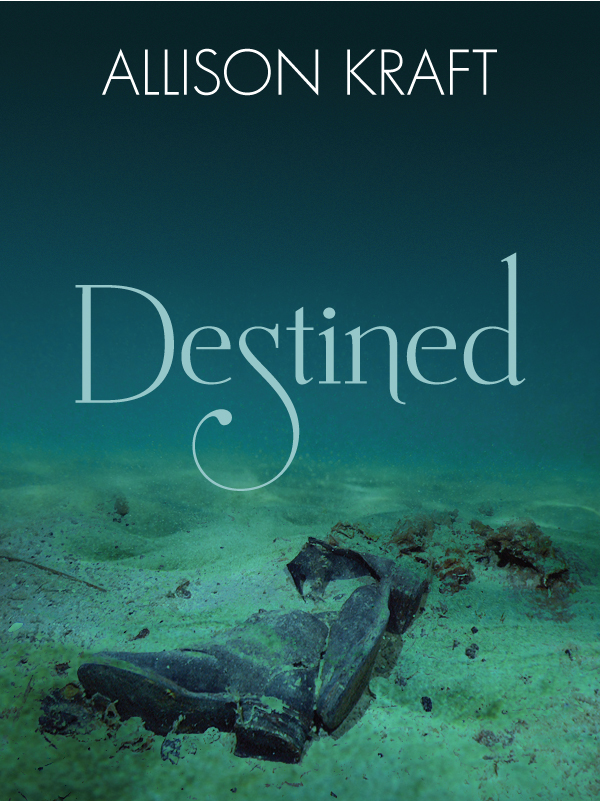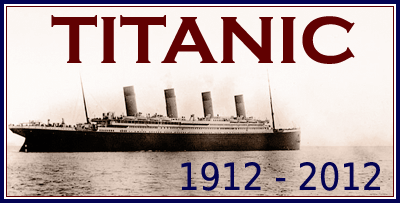
April 11, 1912
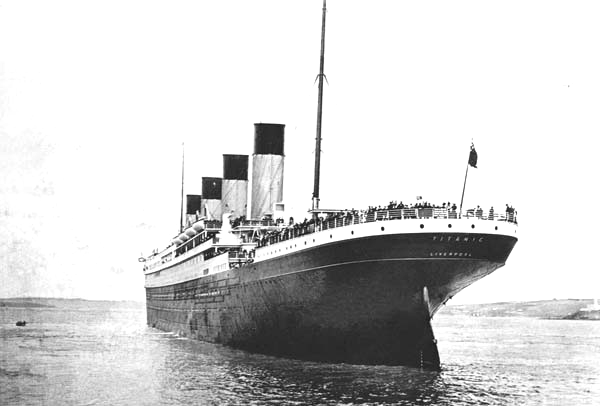 The morning of April 11 was clear but cool, keeping most passengers indoors as the Titanic neared her final stop in Queenstown, Ireland (known today as Cobh). She docked around 11:30am, dropping anchor just outside of Roche's Point, too big to berth at the dock itself. Passengers and mail had to be ferried back and forth on smaller tenders.
The morning of April 11 was clear but cool, keeping most passengers indoors as the Titanic neared her final stop in Queenstown, Ireland (known today as Cobh). She docked around 11:30am, dropping anchor just outside of Roche's Point, too big to berth at the dock itself. Passengers and mail had to be ferried back and forth on smaller tenders.
Not many passengers disembarked in Ireland, but one of these would later turn out to be a boon for Titanic historians. Francis Browne (later known as Father Browne) had been crossing the channel with the O'Dell family in first class. While he was only on the ship a short time, he brought his camera along and took many photographs of the ship's interiors, some of the only photos that would ever be taken in her short life. A full album of his photographs can be found here.
Another man who got off the ship at Queenstown wasn't supposed to: John Coffey, a Irish fireman who signed on in Southampton, deserted the ship in Queenstown by hiding under some bags of mail. It is thought that he used the ship's voyage as a way to get free passage home. More can be found about him in a previous blog post.
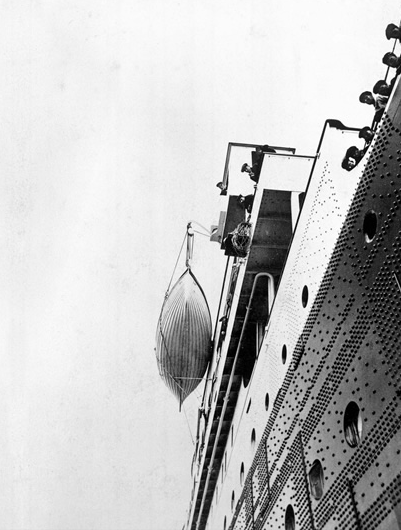 While Titanic is in port, newsmen and others are allowed on board to quickly tour her decks, take pictures and even sell wares to the first class passengers. But not for long, because about two hours after dropping anchor, she is ready to set off again, this time for New York. The photo to the right was taken by Father Browne as he left the ship, the last picture ever taken of Captain Smith, who can be seen peering down from the bridge (top of the image), with one of the lifeboats dangling ominously below.
While Titanic is in port, newsmen and others are allowed on board to quickly tour her decks, take pictures and even sell wares to the first class passengers. But not for long, because about two hours after dropping anchor, she is ready to set off again, this time for New York. The photo to the right was taken by Father Browne as he left the ship, the last picture ever taken of Captain Smith, who can be seen peering down from the bridge (top of the image), with one of the lifeboats dangling ominously below.
No first class passengers boarded at Queenstown, and only a few joined the second class, one of which was Nora Keane, who would be placed in a cabin with Edwina Troutt and Susan Webber (both of which are mentioned in DESTINED). The majority of the people coming onto the ship here were third class: immigrants heading to America to start new lives in the New World. Jeremiah Burke, the boy whose "message in a bottle" was found near his hometown a year later (more on him here), was one of these immigrants.
Shortly after 1:30pm, Titanic raised anchor for the last time and headed out to sea. Out on the stern, in the third class promenade, Irishman Eugene Daly (more on his in John Coffey's blog post, above) sat down to play "Erin's Lament" on his pipes, a sad goodbye to the homeland he would not see again for many years.
Once she was underway, a full emergency dress rehearsal took place among the crew, complete with alarm bells and the closing of all the watertight doors. The lifeboat drill for the passengers was scheduled for Sunday morning, April 14. It would not take place, skipped by the Captain for an unknown reason.
The rest of the day would unfold normally, starting up a routine of relaxing, socializing and dining that would continue on throughout the voyage.
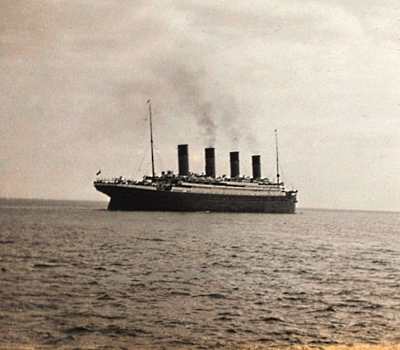
What may be the last photograph taken of the Titanic, as she steams away from Ireland's coast.


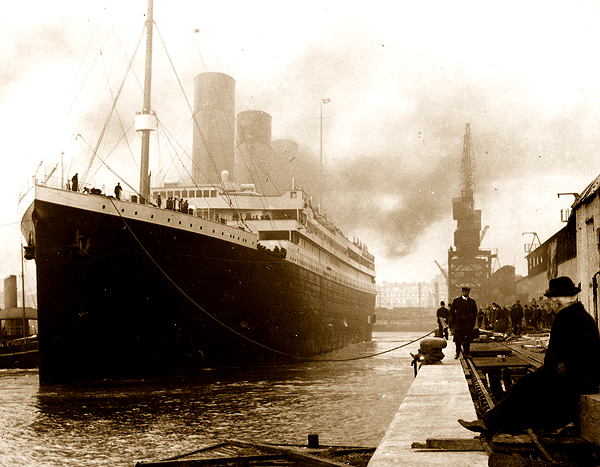 April 10 was a busy day for Titanic. It was sailing day, the first day of her maiden voyage. She would set off from her first port in Southampton, England, at noon, heading across the English Channel for Cherbourg, France.
April 10 was a busy day for Titanic. It was sailing day, the first day of her maiden voyage. She would set off from her first port in Southampton, England, at noon, heading across the English Channel for Cherbourg, France.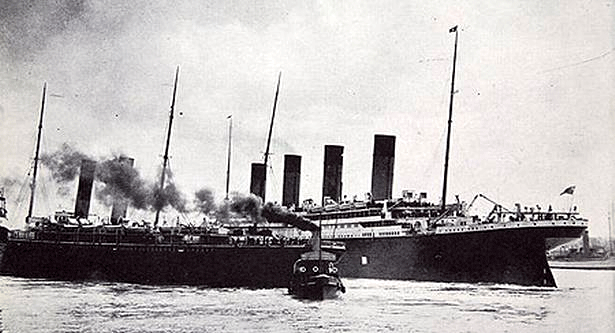 At noon, the ship began to edge away from the dock. As she turned into the channel to head out, her size and increasing speed churned up the water enough that a suction was created, pulling two nearby ships, the Oceanic and New York away from their moorings. Ropes snapped, and the New York was set free. Captain Smith was made aware of the imminent danger and went into action, calling for the engines to be reversed, halting her movement. The New York was corralled by tugs and stopped before Titanic began to move forward again. While this was going on, more lines were added to Oceanic to prevent her from breaking free, and after a tense hour, Titanic was once again on her way. Her voyage had begun, but the incident with the other ships had delayed her an hour, and she would now arrive at her next destination late. A bad omen?
At noon, the ship began to edge away from the dock. As she turned into the channel to head out, her size and increasing speed churned up the water enough that a suction was created, pulling two nearby ships, the Oceanic and New York away from their moorings. Ropes snapped, and the New York was set free. Captain Smith was made aware of the imminent danger and went into action, calling for the engines to be reversed, halting her movement. The New York was corralled by tugs and stopped before Titanic began to move forward again. While this was going on, more lines were added to Oceanic to prevent her from breaking free, and after a tense hour, Titanic was once again on her way. Her voyage had begun, but the incident with the other ships had delayed her an hour, and she would now arrive at her next destination late. A bad omen?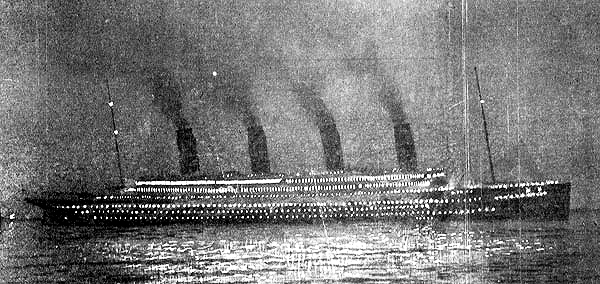 The sun was beginning to set as Titanic finally arrived at the French port. She dropped anchor around 6:30pm and tenders began to ferry the cross-channel passengers and mail off. Other tenders carried the Cherbourg passengers to the ship, along with more mail. The entire process took about 90 minutes, and by 8:00pm, the sun had set and she was ready to set off for Ireland, lights blazing from every porthole. She must have been quite the sight to behold. The photo here was taken shortly after she dropped anchor, before it was fully dark.
The sun was beginning to set as Titanic finally arrived at the French port. She dropped anchor around 6:30pm and tenders began to ferry the cross-channel passengers and mail off. Other tenders carried the Cherbourg passengers to the ship, along with more mail. The entire process took about 90 minutes, and by 8:00pm, the sun had set and she was ready to set off for Ireland, lights blazing from every porthole. She must have been quite the sight to behold. The photo here was taken shortly after she dropped anchor, before it was fully dark.
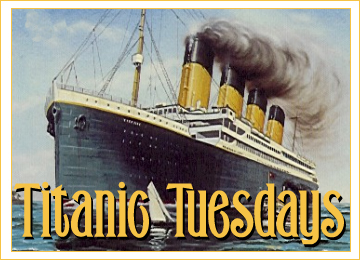
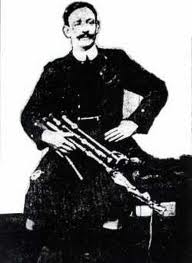 Another Irish passenger that has more information available, and connects more directly to my own book, is Eugene Daly. Daly was 29 years old when he boarded the Titanic in Queenstown, and was most known later for playing “Erin’s Lament” on his uilleann pipes (similar to bagpipes) while the ship left port. A third class passenger, he sat out on the bow and played, a somber farewell to his homeland. According to the
Another Irish passenger that has more information available, and connects more directly to my own book, is Eugene Daly. Daly was 29 years old when he boarded the Titanic in Queenstown, and was most known later for playing “Erin’s Lament” on his uilleann pipes (similar to bagpipes) while the ship left port. A third class passenger, he sat out on the bow and played, a somber farewell to his homeland. According to the 







